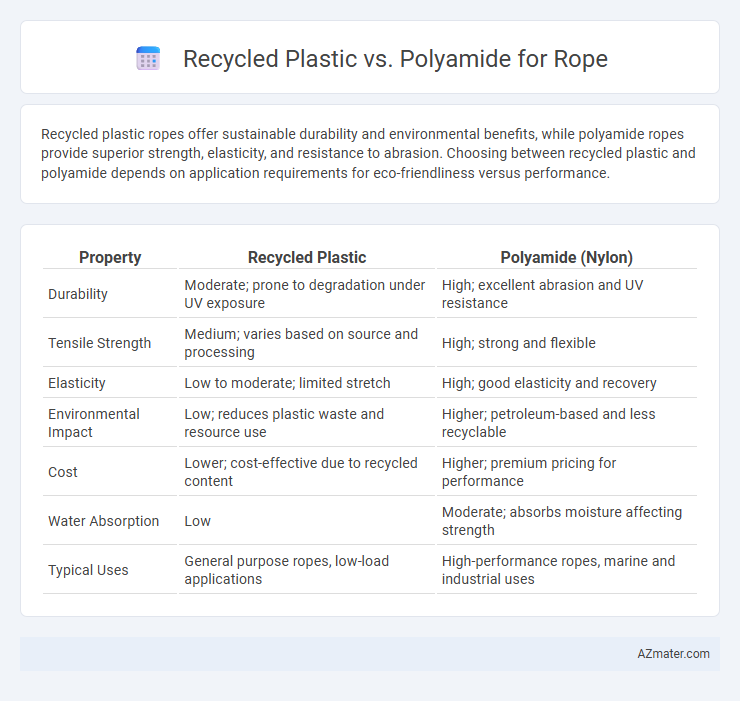Recycled plastic ropes offer sustainable durability and environmental benefits, while polyamide ropes provide superior strength, elasticity, and resistance to abrasion. Choosing between recycled plastic and polyamide depends on application requirements for eco-friendliness versus performance.
Table of Comparison
| Property | Recycled Plastic | Polyamide (Nylon) |
|---|---|---|
| Durability | Moderate; prone to degradation under UV exposure | High; excellent abrasion and UV resistance |
| Tensile Strength | Medium; varies based on source and processing | High; strong and flexible |
| Elasticity | Low to moderate; limited stretch | High; good elasticity and recovery |
| Environmental Impact | Low; reduces plastic waste and resource use | Higher; petroleum-based and less recyclable |
| Cost | Lower; cost-effective due to recycled content | Higher; premium pricing for performance |
| Water Absorption | Low | Moderate; absorbs moisture affecting strength |
| Typical Uses | General purpose ropes, low-load applications | High-performance ropes, marine and industrial uses |
Introduction: The Rise of Sustainable Rope Materials
Recycled plastic ropes are gaining traction for their eco-friendly properties and reduced carbon footprint compared to traditional polyamide ropes. Polyamide, known for its high strength and elasticity, serves various industrial and marine applications but often involves non-renewable resources and longer degradation times. The industry shift towards recycled plastics reflects increasing demand for sustainable materials that maintain durability while lowering environmental impact.
Understanding Recycled Plastic: Types and Sources
Recycled plastic for rope production primarily originates from post-consumer PET bottles, HDPE containers, and discarded fishing nets, offering sustainable raw materials that reduce environmental waste. Common recycled plastic types include PET (polyethylene terephthalate), known for its strength and durability, and HDPE (high-density polyethylene), valued for its flexibility and resistance to chemicals. These recycled plastics are processed into fibers suitable for rope manufacturing, providing an eco-friendly alternative to traditional polyamide ropes while maintaining competitive performance characteristics.
What is Polyamide? Properties and Applications
Polyamide, commonly known as nylon, is a synthetic polymer characterized by high tensile strength, excellent abrasion resistance, and good elasticity, making it ideal for rope manufacturing. Its corrosion resistance, low water absorption, and durability under varying environmental conditions ensure reliable performance in marine, climbing, and industrial applications. Compared to recycled plastic ropes, polyamide ropes offer superior strength-to-weight ratio and consistent quality, though they may have higher production costs and environmental impact.
Environmental Impact: Recycled Plastic vs Polyamide
Recycled plastic ropes significantly reduce environmental impact by diverting waste from landfills and decreasing reliance on virgin petrochemicals compared to polyamide ropes, which are derived from non-renewable fossil fuels and contribute to higher carbon emissions during production. The manufacturing process of recycled plastic ropes consumes less energy and generates fewer greenhouse gases, promoting sustainability in outdoor and industrial applications. End-of-life disposal also favors recycled plastic ropes, as some variants are more recyclable or biodegradable than conventional polyamide materials.
Strength and Durability Comparison
Recycled plastic ropes exhibit high resistance to abrasion and UV exposure, making them suitable for outdoor applications, while polyamide ropes offer superior tensile strength and elasticity, providing better shock absorption under heavy loads. Polyamide's molecular structure grants enhanced durability against dynamic stresses and repeated stretching, whereas recycled plastic ropes may experience decreased flexibility over time. Choosing between recycled plastic and polyamide ropes depends on the specific strength requirements and environmental conditions of the intended use.
Flexibility and Handling Characteristics
Recycled plastic ropes typically offer moderate flexibility with a slightly rougher texture, resulting in less smooth handling compared to polyamide ropes. Polyamide ropes excel in flexibility and exhibit superior elasticity, enabling easier knot tying and better shock absorption under dynamic loads. The enhanced handling characteristics of polyamide make it a preferred choice for applications demanding frequent adjustments and high-performance maneuverability.
Cost Analysis: Production and Longevity
Recycled plastic rope offers significantly lower production costs due to reduced raw material expenses and energy consumption compared to polyamide rope, which relies on more costly synthetic fibers. Polyamide rope demonstrates superior longevity and resistance to abrasion, UV damage, and chemical exposure, often extending service life beyond recycled plastic alternatives despite higher initial investment. Evaluating total cost of ownership, recycled plastic excels in budget-sensitive applications, while polyamide justifies its premium through enhanced durability and less frequent replacement.
Safety and Performance in Different Conditions
Recycled plastic ropes offer excellent chemical resistance and UV stability, making them safer for marine and outdoor environments where exposure to sunlight and corrosive substances is common. Polyamide ropes provide superior elasticity and abrasion resistance, ensuring enhanced shock absorption and durability under dynamic loads in climbing and rescue operations. In wet or cold conditions, polyamide maintains strength and flexibility better than recycled plastic, which can become stiff and brittle, potentially compromising safety and performance.
End-of-Life Management and Recyclability
Recycled plastic ropes offer significant advantages in end-of-life management due to their compatibility with existing recycling streams and reduced environmental impact compared to polyamide. Polyamide ropes, while durable, present challenges in recyclability because of their complex chemical structure, often leading to landfill disposal or incineration. Emphasizing recycled plastic ropes enhances circular economy efforts by enabling easier reprocessing and reducing reliance on virgin materials.
Choosing the Right Rope Material: Key Considerations
When choosing rope material, consider durability, environmental impact, and application-specific performance. Recycled plastic ropes offer eco-friendly benefits and good resistance to moisture and UV exposure but may lack the strength and abrasion resistance of polyamide ropes. Polyamide ropes provide superior tensile strength, elasticity, and abrasion resistance, making them ideal for heavy-duty and dynamic loads where performance and reliability are critical.

Infographic: Recycled plastic vs Polyamide for Rope
 azmater.com
azmater.com